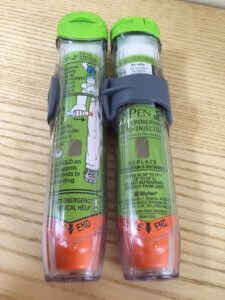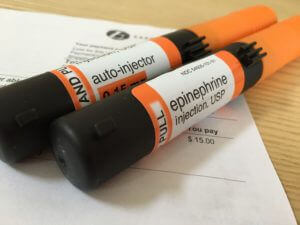NOTE: This is in no way intended as a product endorsement, but rather one mom’s experience. Please consult your doctor and insurance provider about any changes in medication —

The cost of one set of EpiPens skyrocketed over the last few years
The first time I bought a set of EpiPens, in 2015, I balked at the price.
“Did insurance not cover this?” I asked the CVS pharmacist.
“That price is with insurance,” she explained. “Most people bring in a coupon so it’s cheaper.”
I sighed, handing over my credit card for the charge; I believe it was over $100. Stinks for the new kid on the allergy block.
Since I was leaving the next day for our home in Asia with my husband and allergic child, what could I do?
This year, as the expiration date on my set of EpiPens loomed, troubling news surfaced: Mylan, the maker of the ubiquitous epinephrine auto-injector, had hiked the price 461 percent since 2007, while over the same period, the company’s CEO got a 671 percent pay raise, to a salary of more than $18 million.
I’m sure every allergy mom felt the same as I did.
Ew.
So, I stressed about renewing my prescription. I didn’t like the cost-and-salary-raise scandal, and my research suggested the company’s solution of throwing more coupons at consumers may only be perpetuating the problem of healthcare spending in the United States. How could I possibly support such a company, but what choice did I have?
I needed not only one new set of EpiPens, but two, since my son was starting preschool for the first time, and his overseas preschool does not have the auto-injectors on hand.
The truth is, if you don’t know your options, you don’t have any options. And, somehow, I didn’t know there were other options.
Without the media hullaballoo, I likely wouldn’t have thought to seek out an alternative. I would’ve simply toed the line and bought the costly version of a necessary medicine. In the outrage resulting from revelations about Mylan, though, my free-market-supporting brother sent me an article about Adrenaclick, an off-brand auto-injector.
Sure enough, I asked my son’s doctor if there was another version appropriate for us, Adrenaclick or anything else, that my insurance would cover.
There was.
 When I got my new, and different, medication, guess what the co-pay was, for two sets?
When I got my new, and different, medication, guess what the co-pay was, for two sets?
$15.
It doesn’t have a fancy name—in fact, it says only “epinephrine auto-injector” and the child’s dosing, but I don’t need a fancy name. It’s like using Target’s brand of tissues. It’s not Kleenex, but there’s no qualitative difference, other than the name.
Of course, there is a difference in method. Like the EpiPen, my off-brand auto injector is a spring-loaded syringe of epinephrine. The removable caps are different, but as long as everyone at home and school reads the instructions or watches the instructional video online, there won’t be a problem if—God forbid—my son has an anaphylactic reaction.
Is an off-brand right for you or your child? The only way to know is to talk to your doctor and your insurance provider.
For more, check out this Consumer Reports article about the cheaper EpiPen alternative.


 #NewsMomReviews
#NewsMomReviews
5nnctq
wvne63
6j17d4
fl28a6
k8r5c5
frnfe8
avs7yf
akor7f
qrf8do
fkkyu4
oog9dq
v913tv
wnn4zb
nrxakp
cuax9r
svzeoh
ya60d7
ov0fbu
ww67i7
9xp6qd
9h0xzm